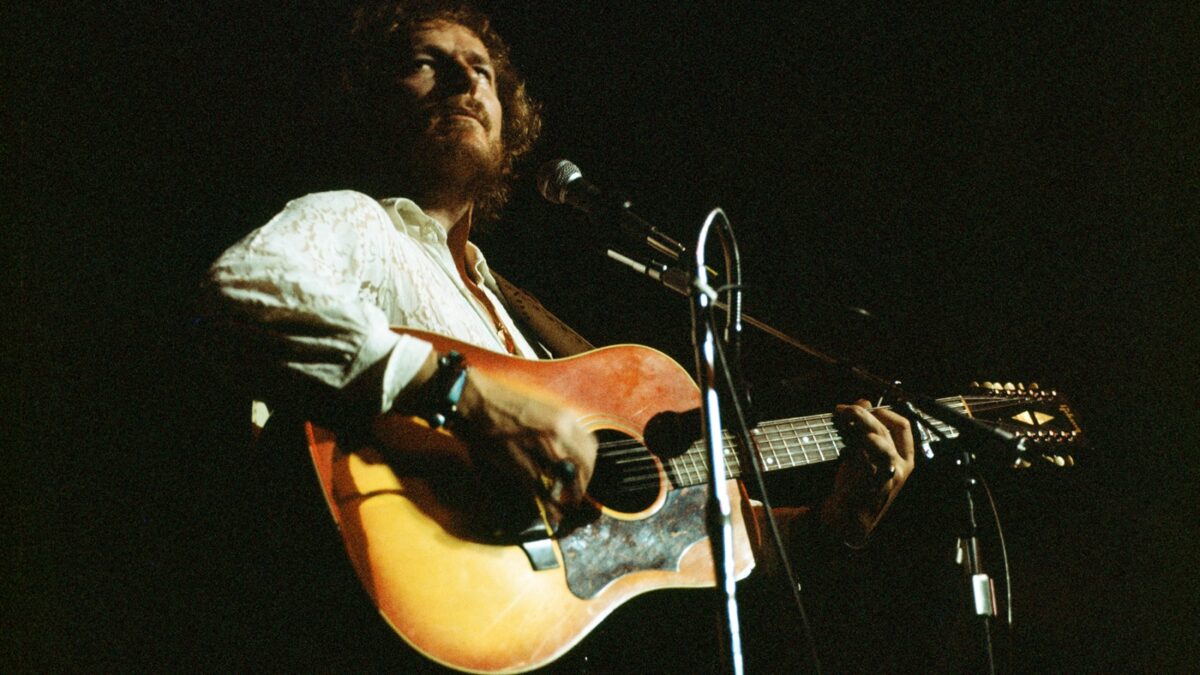
So many brilliant songwriters came out of Canada in the Sixties — legends like Leonard Cohen, Joni Mitchell, Neil Young, and Robbie Robertson — that the talents of are sometimes overlooked by those who don’t know better. He never even appeared on a Rock and Roll Hall of Fame ballot before his death at 84. That’s a raging injustice when you listen back to gems like “If You Could Read My Mind,” “Carefree Highway,” and “Early Morning Rain.” These songs earned him a sterling reputation as a songwriter’s songwriter, which you can see when you check the list of people who covered them: Bob Dylan, Johnny Cash, Elvis Presley, and countless others. Or you can take it from Dylan himself, who famously remarked, “I can’t think of any Gordon Lightfoot song I don’t like. Every time I hear a song of his, it’s like I wish it would last forever.” Here’s a guide to ten of Lightfoot’s best songs.
“For Lovin’ Me” (1966)
Long before most music fans knew the name Gordon Lightfoot, they knew his music thanks to tunes like “For Lovin’ Me.” A bitter song of self-loathing directed at a former lover (“I ain’t the kind to hang around/With any new love that I found/’Cause movin’ is my stock in trade”), it first appeared on his 1966 debut, Lightfoot!, and was covered within a few years by Peter, Paul, and Mary, Ian & Sylvia, Waylon Jennings, Johnny Cash, and the Carter Family. In 1973, Elvis Presley put his spin on it. And in 1975, a now-established Lightfoot re-recorded it for his Gord’s Gold compilation. He merged it with “Did She Mention My Name?” on that release, completely transforming the song by revealing the loneliness that comes when you close your mind to love and human connection. —A.G.
“Early Morning Rain” (1966)
“Early Morning Rain,” a briskly strummed meditation on longing and losing, is both one of Lightfoot’s first compositions and one of his most influential. He sings about his lover leaving him on a plane while he stays grounded and drunk. “You can’t jump a jet plane like you can a freight train,” he sings, “So I’d best be on my way/In the early mornin’ rain.” Like many of his early songs, it was widely covered; John Denver even credited the tune with inspiring his own “Leaving on a Jet Plane.” But it was Dylan’s cover on 1970’s Self Portrait that Lightfoot felt affected him most. “I was totally blown away that he would record one of my songs in the first place,” Lightfoot once told Mojo. “It helped my career. I’d not had a hit single myself at that point. His cover was a linchpin in that whole process because it made people in the industry aware that I was producing good songs.” —K.G.
“Canadian Railroad Trilogy” (1967)
A six-and-a-half minute folk ballad about the creation of the Canadian Pacific Railway would be a slog in the hands of most songwriters. But when the Canadian Broadcasting Corporation asked Lightfoot to write the historical song to celebrate Canada’s centennial year in 1967, he poured his heart into the task and emerged with a masterpiece about the history of his country and the resilience of the human spirit. “I stayed up all night working on it, right up until nine or ten in the morning,” Lightfoot said. “Then sleep and pile right back into it. Coffee, cigarettes — nothing else. No booze at that point. The song was done in three days.” The end result was so beloved that even Queen Elizabeth became aware of it. “I met her in our capital, Ottawa, at a Canada Day celebration,” Lightfoot said in 2016. “She told me how much she loved the ‘Canadian Railroad Trilogy.’ She looked at me and said, ‘Oh, that song,’ and then said again, ‘That song,’ and that was all she said.” —A.G.
“Did She Mention My Name?” (1968)
The gift for well-turned tales of heartbreak that would endear Lightfoot to country audiences in the years to come is in full effect on this 1968 gem, from his John Simon-produced third album. The narrator is catching up with a friend he hasn’t seen in years, and he tries to play it cool as they chat about the old days. But he’s only able to hold off on the question that’s haunting him until the last line of each verse: “Is the home team still on fire? Do they still win all the games? And by the way, did she mention my name?” In its understated tone, only hinting at all the regret beneath the surface, the song treads some of the same ground Dylan would explore a few years later with “If You See Her, Say Hello.” —S.V.L.
“If You Could Read My Mind” (1970)
“If You Could Read My Mind” is the Canadian cousin of “You’re a Big Girl Now”: a divorce dirge that’s a corkscrew to the heart, but you play it over and over again anyway, because that’s the power of a Lightfoot song. He barely takes a breath here, dropping each line drenched in imagery and sorrow. Anyone else would sound ridiculous comparing their pain to being “In a castle dark or a fortress strong/With chains upon my feet.” The song was such a hit that the album it was released off of — 1970’s Sit Down Stranger — was quickly renamed after it. It’s so beloved that everyone from Viola Willis to Gene Clark to Neil Young has covered it. The Replacements’ Paul Westerberg even joked that he wants it to be sung at his funeral. —A.M.
“Sundown” (1974)
One of the most ominously pretty songs about infidelity ever written, “Sundown” was Lightfoot’s sole Number One hit in the U.S. “We knocked Paul McCartney out of first place,” he later said. “That’s as close as I got to catching up to [the Beatles], because they were always there, and you always had to compete against them.” Lightfoot’s voice is warm and moody as he issues a warning to his erstwhile lover’s new companion: When he sings, “Getting lost in her lovin’ is your first mistake,” you can almost smell the night air rustling the folds of her satin dress. “It’s got a good beat to it,” Lightfoot has said, downplaying the classic. “It’s got interesting harmonic passages. It has a great arrangement and not too bad of a vocal. If I was going to do it again, I’d probably try to do the vocal again.” We’d have to disagree, but his willingness to tweak even his most popular song decades later speaks to an unmatched mastery. —B.E.
“Carefree Highway” (1974)
Lightfoot was “driving from Flagstaff to Phoenix, about 1:30 in the morning, trying to make it to catch a plane back to Toronto” when he saw the road sign that inspired this mid-Seventies hit. To desert commuters, Arizona State Route 74 is a useful 30-mile stretch of pavement; to Lightfoot, its poetic nickname evoked the story of a restless soul on the road, wandering the Southwest with an old flame named Ann on his mind. She’s way back in his rearview mirror — he can’t even quite remember her face anymore — but he can’t forget her, either, as the wistful chords roll on. “I saw ‘Carefree Highway’ and said to the bass player, ‘That sounds to me like a song title,’” he recalled years later. —S.V.L.
“Rainy Day People” (1975)
Part of Gordon Lightfoot’s genius was his ability to transform a simple idea into something beautiful. On “Rainy Day People,” he’s addressing true friends who don’t back away when times get tough. “Rainy day people always seem to know when it’s time to call,” he sings. “Rainy day people don’t talk, they just listen till they’ve heard it all.” The song peaked at Number 26 on the Hot 100, way below Freddy Fender’s “Before The Next Teardrop Falls,” Tony Orlando and Dawn’s “He Don’t Love You (Like I Love You),” and “The Immigrant” by Neil Sedaka. Many of those songs are long forgotten by now, but the universality of “Rainy Day People” has allowed it to endure. —A.G.
“The Wreck of the Edmund Fitzgerald” (1976)
A freighter carrying iron ore across Lake Superior sank, killing all 29 crew members, during a November storm in 1975, inspiring Lightfoot’s six-and-a-half–minute prog-folk story song. Amid swaying guitar and some tasteful keyboard lines, Lightfoot paints a full portrait of the disaster, singing about the lake, the ship, and its crew. His passion for the story resonated with listeners, and the song made it up to Number Two on Billboard’s Hot 100. The town of Superior, Michigan even made him an honorary citizen for drawing attention to the wreck’s victims. “It means a whole lot to me sharing that with the world, and meeting a lot of people that have related in one way or another … to shipping on the Great Lakes,” he told Rolling Stone. “It’s been an opportunity to meet with hundreds of people who in some way have identified with somebody or something that had to do with that unfortunate tragedy.” —K.G.
“Daylight Katy” (1978)
In the late Seventies, rock, country, pop, and disco were all melting together into a soft-serve swirl of easy-listening effluvia. Lightfoot found himself right at home in this gilded morass on “Daylight Katy.” In this song, he’s looking to end up on the winning end of the “Sundown” dynamic, playing the potential benefactor of a backstairs-creeping filly, who “walks to the sea where the seaweed is.” Gordo coolly holds Katy at bay with his casually resigned, take-or-leave-it baritone. “If you can’t follow me down/Daylight Katy go home,” he offers. Rolling Stone wasn’t super kind to Endless Wire: “Lightfoot’s latest LP lacks even the minor virtues that used to make him bearable.” But “Daylight Katy” is a keeper — the song is, we mean. As far as Katy herself….eh, let’s wait til daylight and see how it goes. —J.D.













